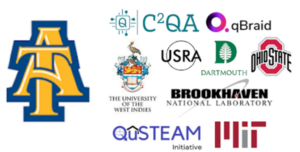A team at Ohio State is part of a multi-institution effort that was just awarded $5M from the NSF’s ExpandQISE program. To meet the growing national demand for a quantum-trained workforce, the ExpandQISE program aims to strengthen connections between institutions already active in quantum science, with institutions that are committed to launching new efforts and that can draw on a diverse and broad population of students. The new award is led by Professor Ray Samuel at North Carolina A&T University, which is the largest public HBCU and a leader in STEM degrees awarded to African-American students. The team includes co-PIs Jay Gupta (Ohio State Physics), Troy Van Voorhis (MIT) and Davide Venturelli (University Space Research Association), but also features collaborators from Dartmouth, University of the West Indies, Brookhaven National Lab, and qBraid (a leading quantum software company).
This diverse team grew out of the extensive QuSTEAM network, developed as part of a previous NSF award in undergraduate quantum education led by Ohio State.
